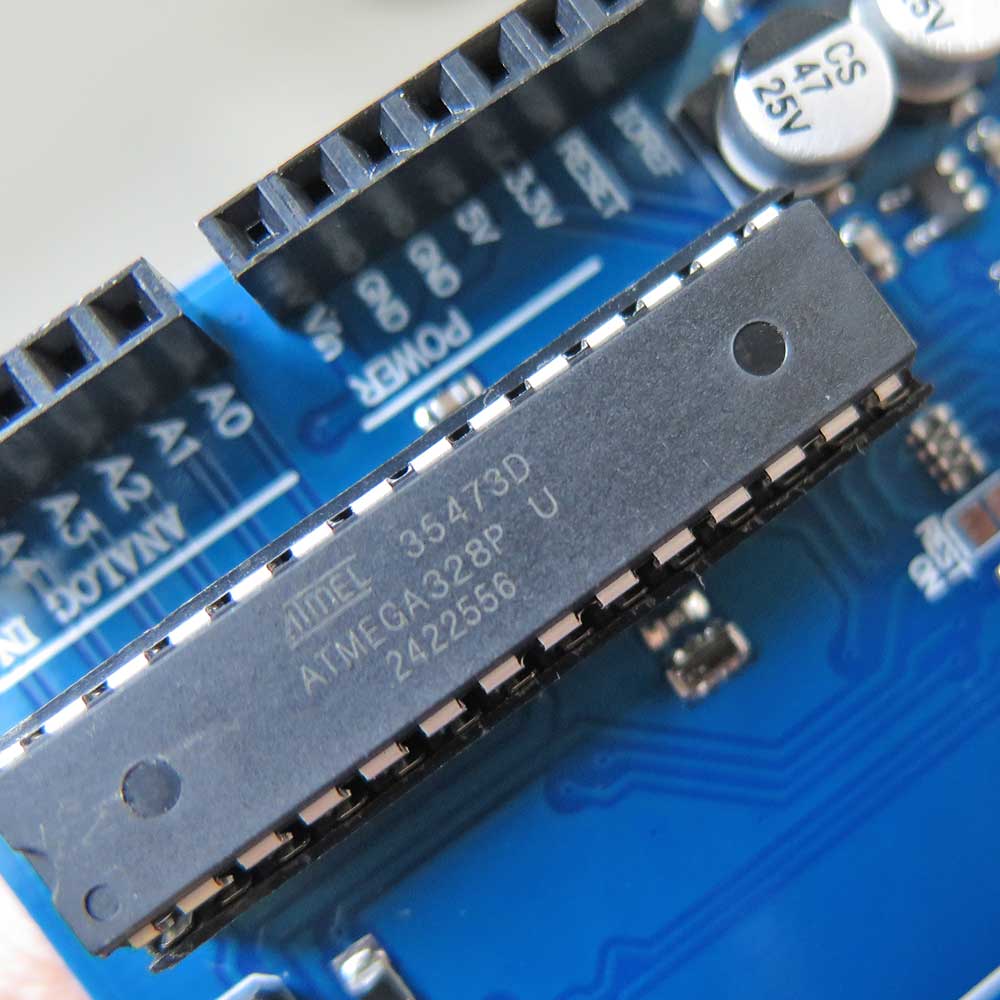484,500 تومان
در حال حاضر موجود نمی باشد
علاقه مندان : 43 نفر
وضعیت : فعال
تعداد مرجوعی : 0
دنبال کنندگان : 48 نفر
قدمت : 8 سال و 7 ماه و 24 روز
وزن : 28 گرم
کل فروش : 11261 عدد
تعداد سفارش ها : 5615 سفارش
4 از 5.0 با 187 رای
برد UNO R3 با پردازنده ATmega328P
ورژن بردهای سری UNO می باشد که در مقایسه با ورژن های قبلی برد آردوینو UNO ، تغییراتی را ایجاد کرده است. این برد با پردازنده ATmega328P به صورت DIP و قابل جدا شدن امکان را فراهم میکند تا در صورت نیاز به تعویض، عملکرد برد مختل نشود. برد UNO R3 ، با داشتن پورت USB، باعث می شود تا در صورت عدم تغذیه برد از پورت 3.3 ولتی، با اتصال USB، تغذیه برد فراهم شود. وجود رگولاتور 3.3 ولتی روی برد سبب شده تا ایمنی و حفاظت از آن با خیال راحت انجام شود و در صورت اتصال برد به تغذیه بیش از 3.3 ولت، آسیبی به برد وارد نشود.
UNO R3 از جمله بردهای اپن سورس با نوسان ساز 16 مگاهرتزی می باشد. نکات مثبت این برد به همین جا ختم نمی شود و داشتن دکمه ریست، LEDهای نمایشگر وضعیت برد، سوکت ورودی منبع تغذیه، امکان راه اندازی برد با آداپتور یا باتری از دیگر مزایای این برد می باشند.
برد آردوینو UNO مدل R3 با داشتن 14 پین ورودی و خروجی دیجیتال (6 پین PWM و 6 پین آنالوگ) به راحتی و بدون نیاز به نصب درایور با سایر مازول های ارتباط برقرار می کند.
برد آردوینو در مقایسه با برد UNO تغییرات سخت افزاری بزرگی نداشته و دو پین SDA و SCL را اضافه نموده و دکمه ریست آن را به منظور دسترسی راحت تر و جلوگیری از آسیب رسیدن به سایر قسمت برد، در گوشه قرار داده اند.
کاربرد برد آردوینو UNO R3 با پردازنده ATmega328P:
- پروژه و مدارات الکترونیکی
- مدارات کنترل کننده شرایط محیط
مشخصات برد آردوینو UNO R3 با پردازنده ATmega328P:
- میکروکنترلر: ATmega328
- سرعت کلاک: 16MH
- ولتاژ عملیاتی: 5 ولت
- ولتاژ ورودی (پیشنهادی): 7-12ولت
- ولتاژ ورودی (محدوده): 6-20ولت
- پین های دیجیتال ورودی/خروجی: 14 (6 تای آن به عنوان خروجی PWM استفاده می شود.)
- پین های ورودی آنالوگ: 6
- جریان DC هر پین ورودی و خروجی: 40 میلی آمپر
- جریان DC جهت پین 3.3 50ma: v
- حافظه فلش: 32 کیلوبایت (ATmega328) که 0.5 کیلوبایت از آن مورد استفاده BootLoader قرار می گیرد
مستندات:
بررسی برد آردوینو UNO R3
Description:
The Arduino UNO R3 is a microcontroller board based on a removable, dual-inline-package (DIP) the ATmega328. Arduino is an open-source, prototyping platform and its simplicity makes it ideal for hobbyists to use as well as professionals. The Arduino UNO has 14 digital input/output pins (of which 6 can be used as PWM outputs), 6 analog inputs, a 16 MHz crystal oscillator, a USB connection, a power jack, an ICSP header, and a reset button. It contains everything needed to support the microcontroller; simply connect it to a computer with a USB cable or power it with an AC-to-DC adapter or battery to get started.
Programs can be loaded on to it from the easy-to-use Arduino computer program. The Arduino has an extensive support community, which makes it a very easy way to get started working with embedded electronics. The R3 is the third, and latest, revision of the Arduino Uno.
The Uno R3 also adds SDA and SCL pins next to the AREF. In addition, there are two new pins placed near the RESET pin. One is the IOREF that allow the shields to adapt to the voltage provided from the board. The other is not connected and is reserved for future purposes. The UNO R3 works with all existing shields but can adapt to new shields that use these additional pins.
Application:
Electronics Circuits
Electronic Projects
etc.
Features:
1.Microcontroller: ATmega328
2.Operating Voltage: 5V
3.Input Voltage (recommended): 7-12V
4.Input Voltage (limits): 6-20V
5.Digital I/O Pins: 14 (of which 6 provide PWM output)
6.Analog Input Pins: 6
7.DC Current per I/O Pin: 40 mA
8.DC Current for 3.3V Pin: 50 mA
9.Flash Memory: 32 KB of which 0.5 KB used by bootloader
10.SRAM: 2 KB (ATmega328)
11.EEPROM: 1 KB (ATmega328)
12.Clock Speed: 16 MHz








